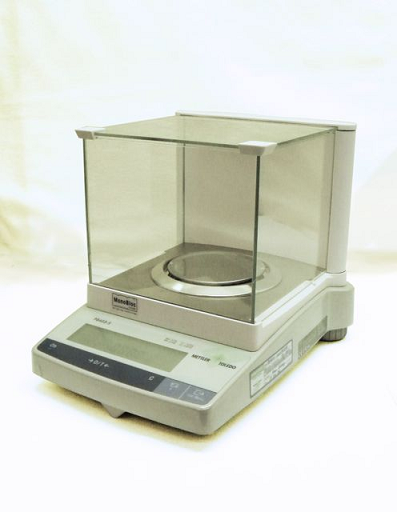Analytical Balance
Watch the movie on using an analytical balance. Analytical balances are used for very accurate, quantitative measurements of mass to the nearest 0.001 g. (Some read to 0.0001 g.) These are delicate instruments, subject to errors caused by vibration and drafts. These problems can be minimized with care and a certain amount of common sense.
Figure 1
To Weigh a Solid Object That is Not a Reagent
Open the draft shield door and gently place the object on the center of the pan. Close the door; the mass will be displayed. Record the mass. Never weigh solid or liquid reagents directly on the pan. Weighing paper or a container such as a beaker should be used for this purpose as described below.To Tare a Container and Weigh a Reagent
1
Open the draft shield door and gently place the container (or weighing paper) on the center of the pan. Close the door; the container mass will appear on the display. Record it in your data table.
2
Calculate a target mass (mass of desired chemical and tare mass).
3
Open the draft shield door and remove the tared container. With the container on the bench top, dispense the chemical.
4
Place the container back on the balance pan and check the mass. If you need to add more chemical, remove the container from the balance and add it, then check the mass again. Repeat this process until the target mass is reached.
5
Close the door and record the mass from the display. Carefully remove the container from the pan and close the door when finished.
A Few Other Tips on the Use of the Analytical Balance
-
1Do not dispense chemicals into a container while it is on the balance pan. This prevents spills in the balance chamber, which is difficult to clean. If you spill something near the balance, clean it up.
-
2The target mass is just that, a target. It is very difficult to dispense an exact mass of chemical. Therefore, experiments are set up to require an approximate mass, but the experimenter records the exact mass of the chemical he/she dispensed. For example:
- The experiment states "obtain about 0.5 g of the unknown." The student finds the tare mass of the container to be 34.568 g. The target mass for container and chemical is 35.068. The student dispenses chemical according to Step 4 above. On his last addition, he overshoots the target mass by a bit. He closes the draft shield and records a mass of 35.142 g. He calculates the exact mass of unknown to be 0.578 g and uses this value in his calculations.
-
3If you have overshot your target mass, do not put the excess chemical back into the reagent bottle. Retain it in the experiment, as in the example above, or put it in the waste container.
-
4If you are doing a series of measurements of the mass of an object over a period of time, perform all measurements on the same balance.
-
5Do not bump or place heavy objects on the bench after zeroing the balance.
-
6Let hot objects cool before obtaining the mass.
-
7Obtain the mass of hygroscopic (water absorbing) materials quickly.
